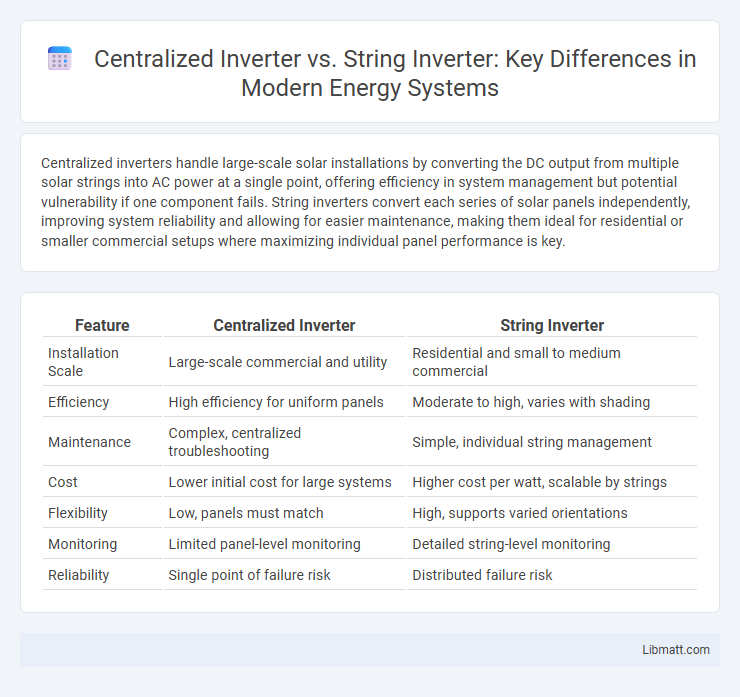Centralized inverters handle large-scale solar installations by converting the DC output from multiple solar strings into AC power at a single point, offering efficiency in system management but potential vulnerability if one component fails. String inverters convert each series of solar panels independently, improving system reliability and allowing for easier maintenance, making them ideal for residential or smaller commercial setups where maximizing individual panel performance is key.
Table of Comparison
| Feature | Centralized Inverter | String Inverter |
|---|---|---|
| Installation Scale | Large-scale commercial and utility | Residential and small to medium commercial |
| Efficiency | High efficiency for uniform panels | Moderate to high, varies with shading |
| Maintenance | Complex, centralized troubleshooting | Simple, individual string management |
| Cost | Lower initial cost for large systems | Higher cost per watt, scalable by strings |
| Flexibility | Low, panels must match | High, supports varied orientations |
| Monitoring | Limited panel-level monitoring | Detailed string-level monitoring |
| Reliability | Single point of failure risk | Distributed failure risk |
Introduction to Solar Inverters
Centralized inverters manage the entire solar array's output, offering high power capacity and simplified maintenance for large-scale solar installations. String inverters convert energy from smaller groups of panels, enhancing system flexibility and enabling better performance monitoring. Choosing the right inverter depends on Your system size and design goals to maximize efficiency and energy yield.
What is a Centralized Inverter?
A Centralized Inverter is a large-capacity power converter used in solar power systems to convert the DC electricity generated by multiple solar panels into AC electricity for the grid. It consolidates the input from many strings of solar panels into a single device, improving efficiency in large-scale photovoltaic installations. Centralized Inverters typically offer higher power output and simplify system maintenance compared to multiple smaller inverters.
What is a String Inverter?
A string inverter converts direct current (DC) from multiple solar panels connected in series into alternating current (AC) for home or grid use, optimizing energy flow from each string. Unlike centralized inverters that handle power from an entire solar array, string inverters manage smaller groups, improving efficiency and fault detection. Your solar system benefits from enhanced performance and easier maintenance with string inverter technology.
Key Differences Between Centralized and String Inverters
Centralized inverters handle the entire solar array's power conversion in a single, large unit, offering simplified maintenance but potentially higher energy loss due to shading or panel mismatch. String inverters convert power for smaller groups of panels individually, enhancing overall system efficiency and allowing easier fault detection but requiring multiple units. Your choice depends on system size, shading conditions, and maintenance preferences.
Efficiency Comparison: Centralized vs String Inverters
Centralized inverters typically offer higher efficiency rates, often exceeding 98%, due to their ability to handle large-scale power conversion with optimized thermal management. String inverters, while slightly less efficient--averaging around 96-97%--provide increased system flexibility by allowing individual strings to operate independently, which can reduce energy losses in shaded or mismatched conditions. The choice between centralized and string inverters significantly impacts overall system performance, especially in large commercial installations versus distributed residential solar arrays.
Installation and Scalability
Centralized inverters typically require a single, larger unit installed near the main distribution panel, making the installation process more straightforward but less flexible for system expansion. String inverters allow for multiple smaller units distributed across different locations, enabling easier scalability and tailored configurations to match varying panel orientations or shading conditions. The modular nature of string inverters supports incremental capacity increases without significant changes to the existing setup, enhancing adaptability for growing solar arrays.
Maintenance and Reliability
Centralized inverters typically require less frequent maintenance due to their robust design and centralized location, but any failure can disrupt the entire solar array's output, impacting overall reliability. String inverters offer greater reliability for your solar system by isolating issues to specific strings, simplifying troubleshooting and minimizing downtime with easier maintenance procedures. Choosing the right inverter depends on balancing your system's scale and maintenance preferences to optimize long-term performance.
Cost Analysis: Upfront and Long-Term
Centralized inverters typically require a higher upfront investment due to their large capacity and centralized design, whereas string inverters offer lower initial costs by utilizing multiple smaller units distributed across the system. Long-term expenses favor string inverters as they allow easier maintenance, isolated failures, and enhanced scalability, reducing downtime and repair costs compared to the single-point failure risk of centralized inverters. Cost analysis reveals string inverters provide better overall value for modular solar installations, while centralized inverters may benefit large-scale projects prioritizing simplified system architecture.
Best Applications for Centralized and String Inverters
Centralized inverters are best suited for large-scale commercial and utility solar power plants where space is ample and system size exceeds several hundred kilowatts, offering higher efficiency and easier maintenance for uniform solar arrays. String inverters are ideal for residential and small commercial installations, providing flexibility in system design, accommodating shading or orientation differences, and simplifying installation by managing smaller groups of panels. Both types enable optimized energy harvest depending on project scale, shading conditions, and budget constraints.
Choosing the Right Inverter for Your Solar Project
Choosing the right inverter for your solar project hinges on system size, installation complexity, and maintenance preferences. Centralized inverters are ideal for large-scale commercial installations due to their high capacity and simpler wiring, while string inverters offer greater flexibility and easier troubleshooting for residential or smaller-scale systems. Evaluating factors like shading, system expansion potential, and budget helps determine the most efficient and cost-effective inverter solution.
Centralized Inverter vs String Inverter Infographic

 libmatt.com
libmatt.com